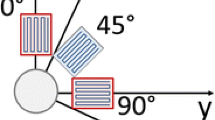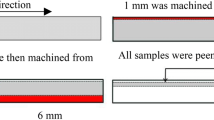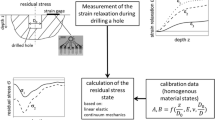Abstract
The residual stress state in thick film systems, as for example thermal spray coatings, is crucial for many of the component’s properties and for the evaluation of the integrity of the coating under thermal and/or mechanical loading. Therefore it is necessary to be able to determine the local residual stress distribution in the coating, at the interface and in the substrate. The incremental hole-drilling method is a widely used method for measuring residual stress depth profiles, which was already applied for thermally sprayed coatings. But so far no reliable hole-drilling evaluation method exists for layered materials having a stress gradient in depth. The objective was to investigate, how far existing evaluation methods of the incremental hole-drilling method that are only valid for residual stress analysis of homogenous material states can be applied to thick film systems with coating thicknesses between 50 μm and 1000 μm and to point out the application limits for these already existing methods. A systematic Finite Element (FE) study was carried out for coating systems with an axisymmetric residual stress state σ1 = σ2. It is shown that conventional evaluation methods developed for homogeneous, non-layered material states can be successfully applied for a stress evaluation in the substrate and the coating for small and for sufficiently large coating thicknesses, respectively, regardless of the type of evaluation algorithm used i.e. the differential or the integral method. The same accounts for material combinations that have a Young’s modulus ratio close to one, between 0.8 and 1.2. The studies indicated that outside the given ranges case specific calibration must be applied to calculate reliable results. Further, calibration data were determined case specifically for a selected model coating system. The accuracy of a residual stress determination using these case specific calibration data was examined and the sensitivity of the evaluation with respect to an accurate knowledge of the boundary conditions of the coating system i.e. the coating thickness and the Young modulus was studied systematically. Finally, the calibration data were applied on a thermally sprayed aluminium coating on a steel substrate analysis and the results for using the incremental hole drilling method were compared to results from X-ray stress analysis.









Similar content being viewed by others
References
Griffiths BJ, Gawne DT, Dong G (1996) The erosion of steel surfaces by grit-blasting as a preparation for plasma spraying. Wear 194(1–2):95–102
Griffiths BJ, Gawne DT, Dong G (1997) The role of grit blasting in the production of high-adhesion plasma sprayed alumina coatings. Proc IME B J Eng Manufact 211(1):1–9
Kuroda S, Clyne TW (1991) The quenching stress in thermally sprayed coatings. Thin Solid Films 200(1):49–66
Kuroda S, Fukushima T, Kitahara S (1990) Generation mechanisms of residual stresses in plasma-sprayed coatings. Vacuum 41(4–6):1297–1299
He MY, Evans AG, Hutchinson JW (2000) The ratcheting of compressed thermally grown thin films on ductile substrates. Acta Materialia 48(10):2593–2601
Clyne TW, Gill SC (1996) Residual stresses in thermal spray coatings and their effect on interfacial adhesion: a review of recent work. J Therm Spray Technol 5(4):401–418
Perry AJ, Sue JA, Martin PJ (1996) Practical measurement of the residual stress in coatings. Surf Coat Technol 81(1):17–28
Wenzelburger M, López D, Gadow R (2006) Methods and application of residual stress analysis on thermally sprayed coatings and layer composites. Surf Coat Technol 201(5):1995–2001
Macherauch E, Müller P (1961) Das sin2ψ-verfahren der röntgenographischen spannungsmessung. Z angew Physik 13:340–345
Eigenmann B, Macherauch E (1995) Röntgenographische Untersuchung von Spannungszuständen in Werkstoffen. Mater Werkst 26(3):148–160
Moore MG, Evans WP (1958) Mathematical correction for stress in removed layers in X-Ray diffraction residual stress analysis. SAE Trans 66:340–345
ASTM E837-08. Standard Test Method for Determining Residual Stresses by Hole-Drilling Strain-Gage method
Santana YY, La Barbera-Sosa JG, Staia MH, et al. (2006) Measurement of residual stress in thermal spray coatings by the incremental hole drilling method. Surf. Coat. Technol. 201(5):2092–2098
Valente T, Bartuli C, Sebastiani M, Loreto A (2005) Implementation and development of the incremental hole drilling method for the measurement of residual stress in thermal spray coatings. J Therm Spray Technol 14:462–470
Buchmann M, Gadow R, Tabellion J (2000) Experimental and numerical residual stress analysis of layer coated composites. Mat Sci Eng A 288(2):154–159
Nelson DV, Makino A, Fuchs EA (1997) The holographic-hole drilling method for residual stress determination. Opt Lasers Eng 27(1):3–23
Schajer G (2010) Advances in hole-drilling residual stress measurements. Exp Mech 50(2):159–168
Schajer G, Steinzig M (2005) Full-field calculation of hole drilling residual stresses from electronic speckle pattern interferometry data. Exp Mech 45(6):526–532
Schwarz T, Kockelmann H (1993) Die Bohrlochmethode - ein für viele Anwendungsbereiche optimales Verfahren zur experimentellen Ermittlung von Eigenspannungen. Messtechnische Briefe 29:33–38
Schajer GS (1988) Measurement of Non-uniform residual stresses using the hole-drilling method. Part I - stress calculation procedures. J Eng Mater Technol 110:338–343
Schajer GS (1988) Measurement of Non-uniform residual stresses using the hole-drilling method. Part II - practical application of the integral method. J Eng Mater Technol 110:344–349
H. Kockelmann, G. König (1987) Ablschlussbericht zum DFG-Forschungsvorhaben Ko 896/2-1 Kennwort: Bohrlochmethode. Stuttgart: Materialprüfanstalt (MPA) Stuttgart;201
König G. Ein Beitrag zur (1991) Weiterentwicklung teilzerstörender Eigenspannungsmeßverfahren. MPA Stuttgart
Moskowitz LN (1993) Application of HVOF thermal spraying to solve corrosion problems in the petroleum industry—an industrial note. J Therm Spray Technol 2(1):21–29
McPherson R (1989) A review of microstructure and properties of plasma sprayed ceramic coatings. Surface and Coatings Technology. 39–40, Part 1(0):173–181
Eigenmann B, Macherauch E (1996) Röntgenographische Untersuchung von Spannungszuständen in Werkstoffen Teil IV. Mater Werkst 27(10):491–501
Eigenmann B, Macherauch E (1996) Röntgenographische Untersuchung von Spannungszuständen in Werkstoffen. Teil III. Mater Werkst 27(9):426–437
DIN EN ISO 14577 Metallic materials - Instrumented indentation test for hardness and materials parameters. In: DIN EN ISO 14577 Metallic materials - Instrumented indentation test for hardness and materials parameters. Berlin: Beuth Verlag
Gibmeier J, Nobre JP, Scholtes B (2004) Residual stress determination by the hole drilling method in the case of highly stressed surface layers. Mater Sci Res Int 10(1):21–25
Gibmeier J, Kornmeier M, Scholtes B (2000) Plastic deformation during application of the hole-drilling method. MSF 347–349:131–137
Author information
Authors and Affiliations
Corresponding author
Rights and permissions
About this article
Cite this article
Obelode, E., Gibmeier, J. Residual Stress Analysis on Thick Film Systems by the Incremental Hole-Drilling Method – Simulation and Experimental Results. Exp Mech 53, 965–976 (2013). https://doi.org/10.1007/s11340-013-9720-y
Received:
Accepted:
Published:
Issue Date:
DOI: https://doi.org/10.1007/s11340-013-9720-y




